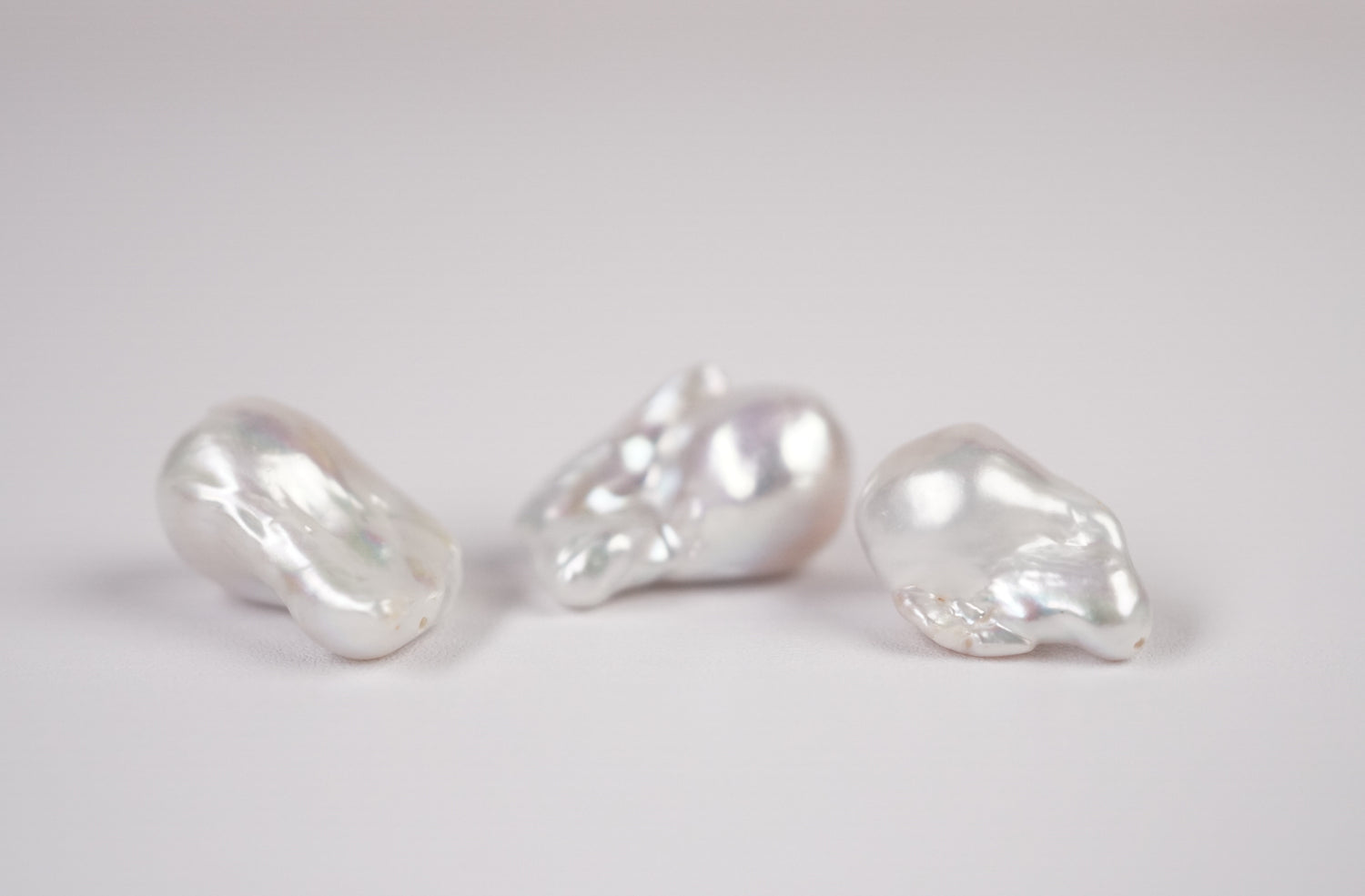Pearl Shapes
While traditionally represented as entirely round, pearls come in many different shapes. When describing their shape, pearls are categorized generally as either round or baroque.

Round Pearls
Pearls categorized as “round” are perfectly spherical. Round pearls are rarer and more difficult to produce, and therefore often more expensive. These pearls offer a classic and elegant style, with an air of sophistication that is immediately recognizable.

Baroque Pearls
Pearls that are any shape other than completely round are described as “baroque.” Baroque pearls are prized for their distinctive forms and natural beauty. These pearls allow for unique and dynamic designs that fit perfectly in both modern and quirky styles. Notably, the price of baroque pearls is on average lower than round pearls. We find it interesting that designs become more affordable as we incorporate pearls with more interesting, dramatic, and attractive shapes.
Types of Baroque Pearl Shapes
Baroque pearls can be further categorized by their basic type of shape. The following list contains examples of some of the more common shapes, but is not completely exhaustive.
Collapsible content
Symmetrical Shapes
Symmetrical pearls are those that are an even shape without being round. Some examples include oval, button, teardrop, rice, and potato-shaped pearls. Symmetrical pearls can be quite rare, as they are influenced by the same factors that make perfectly round pearls rare.
Asymmetrical Shapes
The broadest category of baroque pearl shapes, asymmetric pearls include any shape that is not round or even on two or more sides. A more technical description would be that they are pearls exhibiting neither radial nor bilateral symmetry—a rarity in many products of nature. These pearls have wild and sometimes nebulous shapes, with their irregular surfaces giving off very attractive iridescent flashes. They also tend to be much larger on average while still being very affordable, often costing less than much smaller examples of round or symmetrical pearls while still having high-quality color and surface properties.
Asymmetrical baroque pearls are distinctive and charismatic, making them the perfect choice for anyone who wants to show off their style and individuality for a fraction of the price.
Cross-Shaped Pearls
One of the more striking pearl shapes, cross-shaped pearls form in the shape of an X or cross. They are not cut or assembled, but are grown in this shape using advanced cultivation techniques—primarily in freshwater mussels. Cross-shaped pearls are often used as pendants, but smaller examples are sometimes strung into necklaces or made into earrings.
Bar-Shaped Pearls
Sometimes called “stick pearls,” bar-shaped pearls are a variety of freshwater cultured pearls that are long and flat rather than any approximation of round. Similar to cross-shaped pearls, they are a steep departure from the traditional pearl shape. They can be strung both lengthwise and widthwise, allowing for an array of unique and trendy styles.
Ringed or Circled Pearls
Ringed pearls, also called “circled pearls,” are characterized by the one or more concentric ridges forming “rings” around its body. Often oblong or approaching spherical in their basic form, ringed pearls are popular for their appealing light-play caused by their elaborate surface texture, combining a visual and tactile experience. Like most baroque shapes, ringed pearls tend to be less expensive than round and symmetrical pearls of a similar size, color, surface luster, and quality.
Ringed pearls occur in both freshwater and saltwater pearl varieties and all their accompanying colors. In our opinion, ringed Tahitian Black pearls are the most dramatic and striking of this shape category.
Near-Round Pearls
Near-round pearls are superficially close to spherical, but upon closer inspection are just slightly off. Sometimes referred to “as off-round” or “out-of-round,” they often have irregular flat spots or what is described as a “wobble.” As these pearls have neither the classic perfection of true round pearls nor the interesting and dynamic profile of other baroque shapes, near-round pearls are often considered one of the less desirable shapes and are significantly less valuable. This is exacerbated by disreputable jewelry dealers misrepresenting near-round pearls as round. They can, however, offer an inexpensive alternative to “true” round pearls, especially when set in a piece that can hide its flaws—such as a ring or earring.